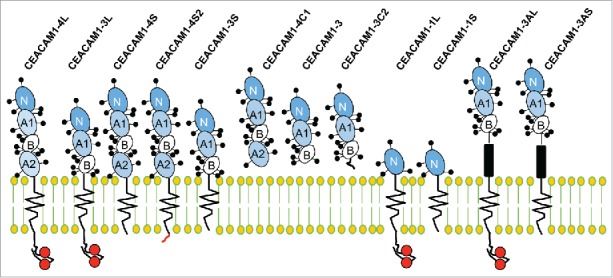Carcinoembryonic antigen-related cell adhesion molecule 1 (CEACAM1), also known as biliary glycoprotein 1, BGP-1 or CD66a, is a type-1 transmembrane protein containing an extracellular N-terminal variable domain followed by up to three constant C2-like immunoglobulin domains. CEACAM1 is the only member of CEACAM family that possesses the immunoreceptor tyrosine-based inhibitory motif (ITIM). Phosphorylation of ITIM in immunization and epithelial cells inhibits signaling through a combination of multiple effector proteins that downregulate cellular signaling. The CEACAM1 gene produces 12 different alternative splicing isoforms (Fig.1). A constant feature is the splicing of mRNA into transcripts encoding two different cytoplasmic domains, either by inclusion (long (-L) tail) or exclusion (short (-S) tail) of CEACAM1 exon.
| Basic Information of CEACAM1 | |
| Protein Name | Carcinoembryonic antigen-related cell adhesion molecule 1 |
| Gene Name | CEACAM1, BGP, BGP1 |
| Aliases | Biliary glycoprotein 1, BGP-1, CD66a |
| Organism | Homo sapiens (Human) |
| UniProt ID | P13688 |
| Transmembrane Times | 1 |
| Length (aa) | 526 |
| Sequence | MGHLSAPLHRVRVPWQGLLLTASLLTFWNPPTTAQLTTESMPFNVAEGKEVLLLVHNLPQQLFGYSWYKGERVDGNRQIVGYAIGTQQATPGPANSGRETIYPNASLLIQNVTQNDTGFYTLQVIKSDLVNEEATGQFHVYPELPKPSISSNNSNPVEDKDAVAFTCEPETQDTTYLWWINNQSLPVSPRLQLSNGNRTLTLLSVTRNDTGPYECEIQNPVSANRSDPVTLNVTYGPDTPTISPSDTYYRPGANLSLSCYAASNPPAQYSWLINGTFQQSTQELFIPNITVNNSGSYTCHANNSVTGCNRTTVKTIIVTELSPVVAKPQIKASKTTVTGDKDSVNLTCSTNDTGISIRWFFKNQSLPSSERMKLSQGNTTLSINPVKREDAGTYWCEVFNPISKNQSDPIMLNVNYNALPQENGLSPGAIAGIVIGVVALVALIAVALACFLHFGKTGRASDQRDLTEHKPSVSNHTQDHSNDPPNKMNEVTYSTLNFEAQQPTQPTSASPSLTATEIIYSEVKKQ |
CEACAM1 was previously described as an adhesion and signaling molecule in epithelial cells, endothelial cells, hematopoietic cells, and tumor cells. Therefore, CEACAM1 is involved in various types of intercellular adhesion and intracellular signaling events that are important for cell survival, differentiation and growth both in normal cells and cancer cells. An interesting feature of CEACAM1 is that it plays a dual role in different cancers. Studies have shown that the expression of CEACAM1 in colon cancer, liver cancer, and prostate cancer can inhibit tumor growth, suggesting that it may act as a tumor suppressor. However, overexpression of CEACAM1 in thyroid and non-small cell carcinoma and melanoma is often associated with poor clinical outcomes and poor survival.
 Fig.1 Human CEACAM1 isotype. (Dankner, 2017)
Fig.1 Human CEACAM1 isotype. (Dankner, 2017)
The results of this study indicated that overexpression of CEACAM1 may significantly inhibit Multiple Myeloma (MM) cell proliferation, induce apoptosis, and inhibit cell invasion and migration by activating caspase-3 and down-regulating MMP-2 and MMP-9.
This article showed a decrease in CEACAM1 concentration during pregnancy, indicating its regulatory role in immune tolerance during pregnancy.
The data of this article indicated that serum levels of CEACAM1 can be used to distinguish between patients with gastrointestinal cancer and healthy controls.
This article demonstrated the critical role of CEACAM1 in B cell aggregate formation in multiple sclerosis (MS) patients and in a B cell-dependent mouse model of MS. These data identified CEACAM1 as a clinically interesting target in the pathogenesis of MS and opened up new therapeutic avenues for the treatment of this disease.
This article revealed that CEACAM1 can inhibit viral spread in ex vivo human decidua organ culture.
Membrane protein studies have advanced significantly over the past few years. Based on our versatile Magic™ membrane protein production platform, we could offer a series of membrane protein preparation services for worldwide customers in reconstitution forms or different membrane protein isotypes. Aided by our versatile Magic™ anti-membrane protein antibody discovery platform, we also provide customized anti-CEACAM1 antibody development services.
During the past years, Creative Biolabs has successfully generated many functional membrane proteins for our global customers. We are happy to accelerate the development of our clients’ programs with our one-stop, custom-oriented service. For more detailed information, please feel free to contact us.
Reference
All listed services and products are For Research Use Only. Do Not use in any diagnostic or therapeutic applications.